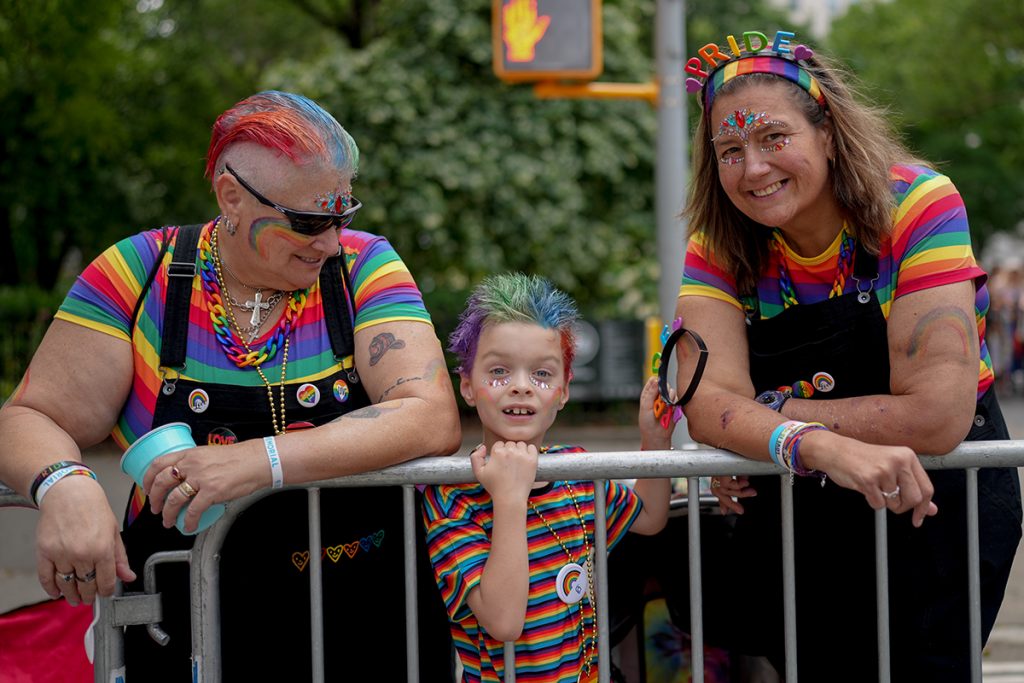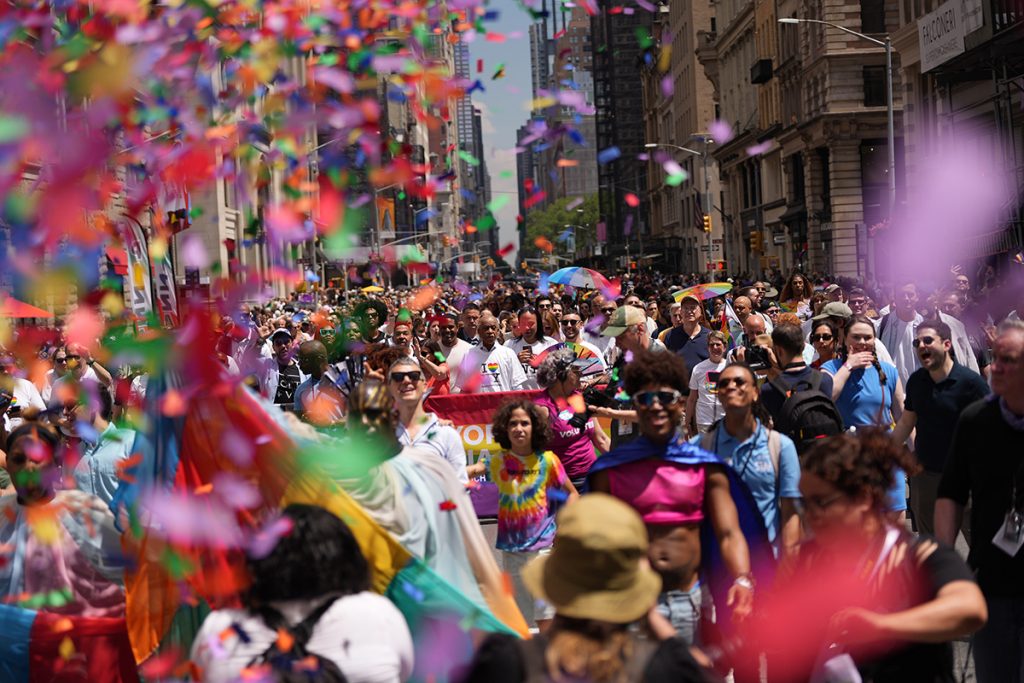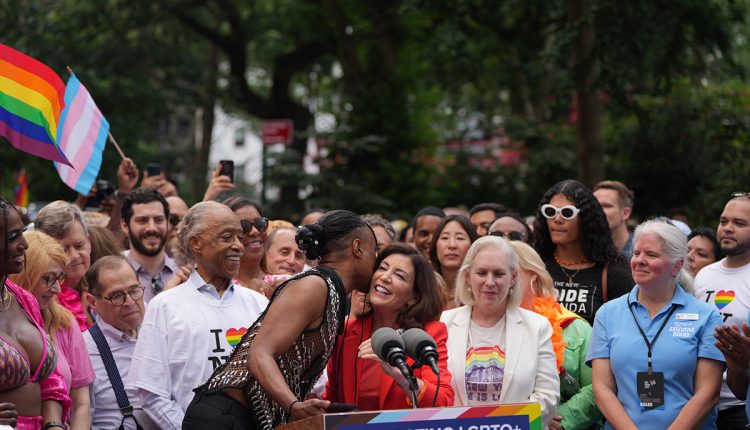Dancing, Jubilation And Worries About LGBTQ Rights At Pride March
The event is even now broadcast on network television
By Liam Stack and Michael Wilson
NEW YORK – An unbroken parade of marchers – some dancing and jubilant, some set with determined purpose – filled Fifth Avenue and the streets of Greenwich Village in Manhattan on Sunday for the New York City Pride March, even as a foreboding backdrop from threats both local and national hung over the day’s slate of events.
The march, with its flags and bright floats, marks the 1969 Stonewall riot that spurred the modern LGBTQ rights movement. It is the largest of its kind in the United States, with 75,000 marchers and roughly 2 million spectators, according to organizers.
The event is even now broadcast on network television, a reflection of the fact that public support for LGBTQ people has never been higher, coming in between 60% and 70% in recent polls.

But backlash to those gains has grown since same-sex marriage became legal nationwide in 2015. In recent years, each successive Pride Month has seemed to go on in defiance of new and ever greater challenges to the LGBTQ community.
Over the past year, states across the country have passed laws banning drag performances and transgender health care, while protests and physical attacks on LGBTQ events and their supporters have cast a pall over gay bars and community centers.
Juli Culling marched with a sign that read, “I march for my daughter” – a fact in more ways than one, having crossed the country with her 18-year-old trans daughter from Southern California in search of a more welcoming home.
“I told her to pick a city,” Culling recalled of the move two years ago, “and she said New York.”
The experience has been deeply rewarding, and her daughter felt comfortable at her new school, Broome Street Academy, but a threat feels attached to any traveling they do.
“We know how the world is right now. It’s scary,” she said. Indeed, her daughter was too anxious to march Sunday, she said.
Conservative-led boycotts against companies that once embraced Pride festivities, such as Target and Anheuser Busch, have led to billions of dollars of corporate losses. The backlash has also entered the 2024 presidential race, as Gov. Ron DeSantis of Florida has staked his Republican primary hopes on opposition to LGBTQ rights and has clashed with corporations, such as The Walt Disney Co., that support them.

Heritage of Pride, which organizes the march, recognized the worsening political climate in an open letter earlier this month that was co-signed with the organizers of dozens of other Pride events across the country. In it, they warned that the LGBTQ community was “under threat” and criticized “fair weather friends” in corporate America.
“Despite the progress we have made together, we are currently under siege,” the organizers wrote. “An alarming rise in legal disruptions and targeted intimidation by extremist groups at these events, across the United States, is making our celebratory gatherings feel less safe. The threats are becoming tangible, terrifying and can no longer be ignored.”
Those threats have taken many forms.
Across the country, a wave of state legislation has targeted LGBTQ young people in particular, banning transgender health care for minors and barring teachers from discussing gay and transgender topics in schools.

In a report released last week, two civil rights groups documented more than 350 acts of anti-LGBTQ harassment, vandalism or violence in the United States between June 2022 and April 2023, with more than half explicitly referring to gay or transgender people as pedophiles.
Some of those incidents have been deadly. Last week, a man was charged with plotting a mass shooting and bomb attack on Nashville Pride in Tennessee. Such a plan was carried out by a shooter in Colorado who killed five people and injured 17 more at a gay bar in November, in what prosecutors have said was a hate crime.
That same month, anxieties were high in New York after a gay bar had its window smashed by bricks four times in one month. Weeks later, the office of a gay New York City Council member was vandalized by opponents of Drag Story Time, who then vandalized his home and assaulted his neighbor.
Even the site of Stonewall Inn, the site of the 1969 riots, has not been spared. In the past month, vandals have struck the national monument outside the bar four times, snapping dozens of its rainbow flags in half.
“Pride feels different this year,” said Erik Bottcher, the City Council member whose home and office were vandalized, and who represents the neighborhood that contains the Stonewall Monument.
“In the past year, there has been an increase in the level of venom that is spewed at our community,” he said. “The rhetoric has been ratcheted up online, at school board meetings and even in Congress. That kind of rhetoric manifests itself in the real world.”
Meanwhile, debates within the LGBTQ community over whether corporations’ embrace of Pride diluted the event’s political roots have given way to a far different reality, as brands back away from that strategy after withering attacks from conservative activists and media figures.
Since April, three companies that released Pride merchandise or partnered with LGBTQ influencers – Target, Anheuser-Busch and Kohl’s – have lost more than $28 billion in market value, according to an analysis by Axios.
The Los Angeles Dodgers, which was criticized by both liberals and conservatives as it publicly waffled over whether to honor a drag troupe this month, saw thousands of protesters descend upon its stadium when it decided to invite the drag queens after all.
And after festooning its stores in rainbow bunting for years, Starbucks declined to decorate for Pride this year at stores in 21 states, according to an employee union.
New York was one of those states. On a recent tour of Starbucks locations in Manhattan, reporters found no Pride decorations in neighborhoods known for their large LGBTQ populations, including Chelsea and Greenwich Village.
Even the Starbucks one block from the Stonewall Inn was rainbow-free. – New York Times



Comments are closed, but trackbacks and pingbacks are open.